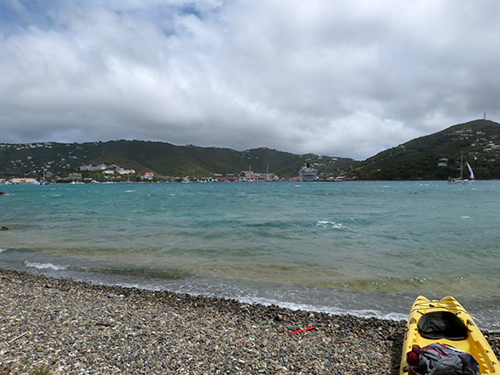After the AMC St. John trip we spent a few added days on St. Thomas. The first night we stayed at the Windward Passage in town (Charlotte Amalie) as Olga’s Fancy where we stayed subsequently was full. The next day we spent at Magens Bay State Park on the north shore of St. Thomas thanks to a courtesy bus from the Windward Passage.

Here we swam and snorkeled until we returned to the Windward. From there we took a taxi to Frenchtown and Olga’s Fancy, a small family owned hotel.

VIew of Olga’s from Hassel Island:

Originally Hassel was just a peninsula, but many years ago they blasted out this channel to provide better water flow to the Charlotte Amalie harbor.
Our room:

View from our balcony to Hassel Island:

View out our back door over Olga’s pool and the Chalotte Amalie harbor :

The adjacent Ocean Restaurant where we had an excellent dinner:

The next day we did a kayak trip with Ecotours to Hassel Island. We’ve been wanting to do this for some time as most of Hassel (there are some private inholdings) is part of the Virgin Island National Park and has a variety of historic sights. The problem is getting there, as the only access is from Frenchtown and that is a long way from St. John.

We met the guide and another couple at 9:30 at the dock in Frenchtown. Another couple cancelled out.

It was somewhat windy and wavy but we quickly kayaked across the channel and docked at the north end of Hassel. From there we walked to the winch house of the Creque Marine Railway:

This railway is unique in that it remains essentially as it was when originally built in the early 1840s. Its principal components of stone slip, stone winch house, and the Bolton machinery housed here are original and was used for repairing boats. It is one of the oldest surviving facilities of its kind in the Western Hemisphere. This was one of the earliest railways to use this technology. A marine railway incorporates 3 elements:
- * An inclined plane or slipway that leads into the water
* A cradle upon which a ship rested out of the water
* A winch device for hauling the cradled vessel up the incline.
The slipway:

Machinery in the winch house:


Then we walked up to the northern peak of Hassel where the British in 1801 built Shipley’s Battery where it held a commanding guard over the western approaches to the harbor. This is the guard house:

Nearby also were ruins of a Leprosarium that was built in 1833 and closed in 1861.
Then we walked back to the kayaks and paddled with modest difficulty against the wind to the south end of Hassel. Here we visited a Garrison House, which was probably an ordnance store building, heavily constructed and well protected for the storage of arms, munitions and other army gear, which was constructed by the British in 1807.


Then we walked up to the higher southern peak of Hassel. Here is situated Covell’s Battery and Signal Station which was constructed by the British in 1801:

From here were great views of the Charlotte Amalie harbor:

We waited out a short rainstorm in Prince Frederik’s Battery before returning to our kayaks.

The return paddle against the 20mph wind with gusts to 40-50mph was exhausting. At times we went backwards.